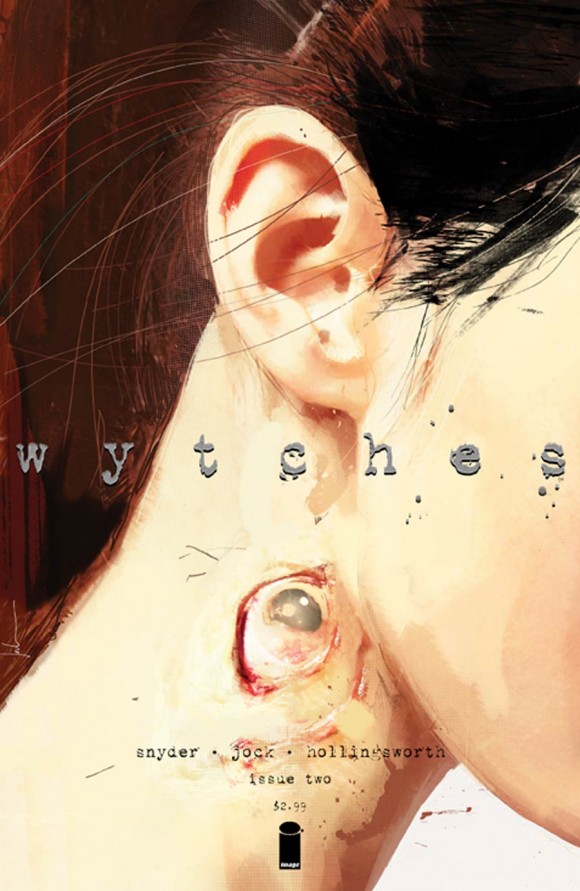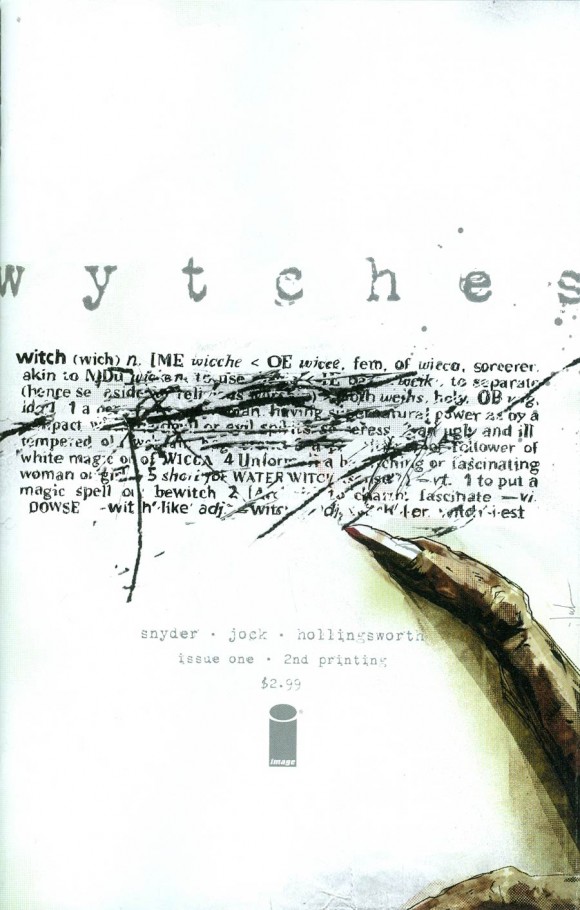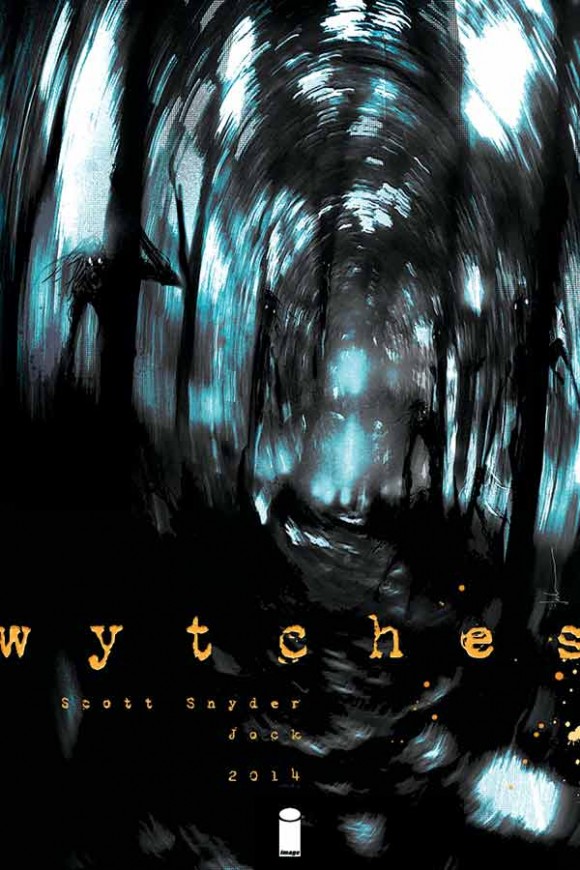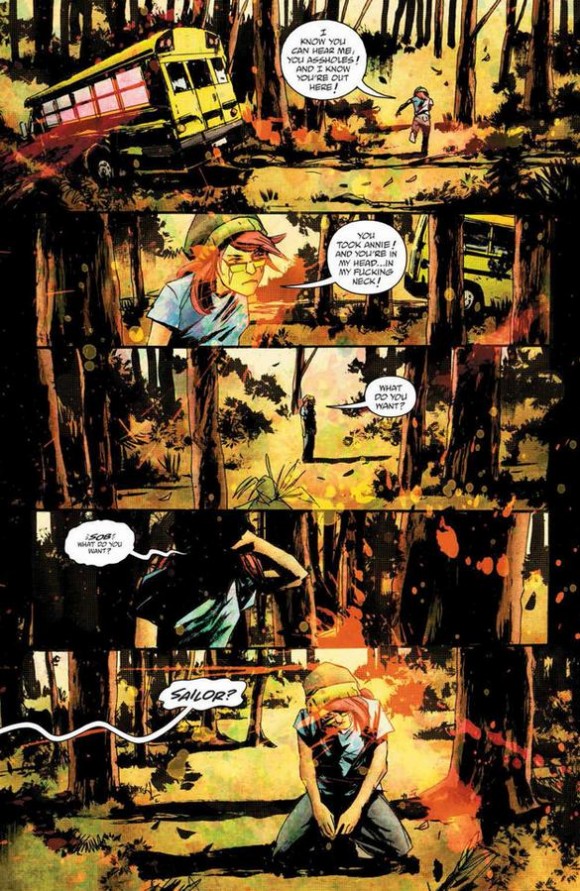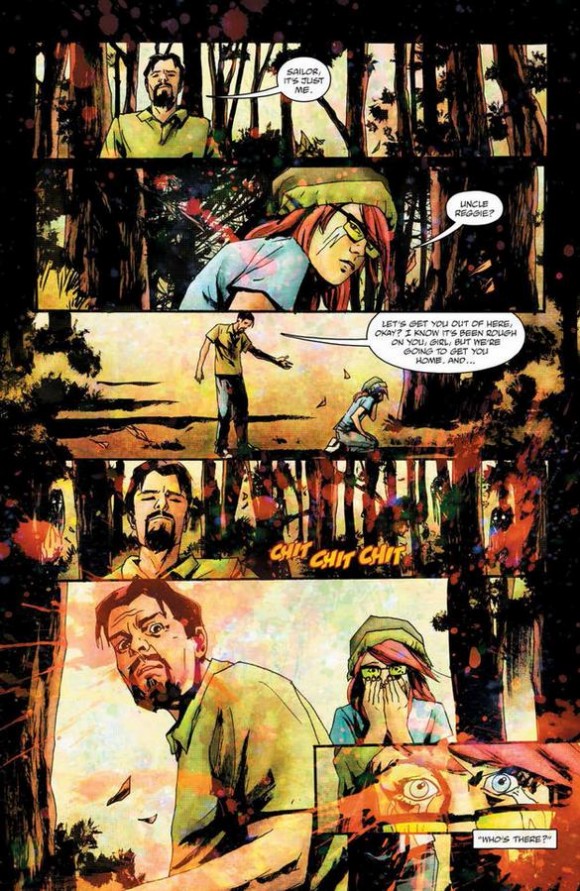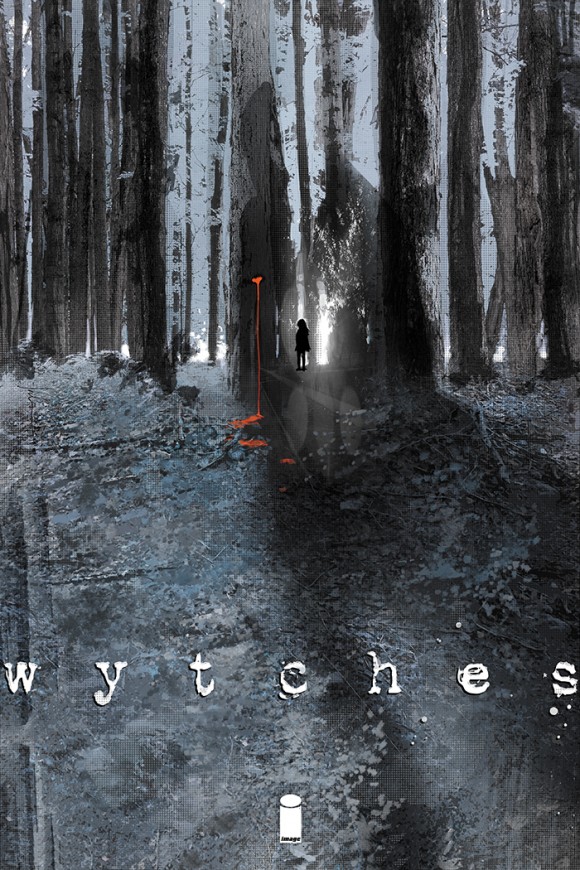The second issue of Image’s Wytches is out 11/12 and our G.D. Kennedy had the opportunity to do a MIGHTY Q&A with Scott Snyder, writer extraordinaire, about the series — and the early stages of the film option.
(Oh, and if you missed Snyder’s 13 Greatest Witches in Pop Culture, check it out here!)
G.D. Kennedy: So I guess the first thing to say is congratulations on the movie and the off-the-bat success of Wytches.
Scott Snyder: Thank you. I really appreciate that.
I was wondering if you could tell us a bit about the movie, what is planned so far, and what your involvement is going to be.
We only just optioned it a (few) weeks ago. Everything is in the really early stages. We were really lucky that Plan B was so enthusiastic about it. They’re a company that both Jock and I knew from the moment that we started getting interest in Wytches, was a place that would do a great job with it. They’ve done so many films that he and I both really love. They do such good stuff that is genre and propulsive and high octane but always sort of extremely character driven and dramatic, ultimately. In that way we felt that they’d be a perfect fit. So far, they’ve been great in keeping us really involved and talking about writers and people to direct it and all that stuff. They’ve been really wonderful with allowing us a seat at the creative table. It’s been great so far. It’s new to me, all of it, and I’m very grateful for it
Is this your first foray into film?
In terms of owning something and optioning it, this is the first time I’ve ever gone through that. I worked with a friend of mine, probably my oldest friend from high school here in New York. It is a format that I really love, and love working in it, too, but this is absolutely the first thing I’ve done that is my own original content, that’s made it over the fence from print to another medium, so I’m really, really thrilled about it. So is Jock. We feel really lucky.
The option was picked up pretty quickly, just a week or so after the comic hit the shelves. Was this something that you were anticipating at all, or did this come out of the blue?
No, we were really hugely surprised and excited. Jock and my agent told us that there was interest in it before it was out because of the buzz and she suggested writing up an outline of where the series was going, and putting together materials for Issues 2 through 5, for the first real arc of the series, explaining where it was going to go and encouraged us to go out with it early. I think Jock and I were really excited by the response initially. But all of it was a whirlwind and a great surprise and a great thrill.
We traditionally see witches as crones. Here, you’ve created some visceral monsters from the first few glances that we get in the first issue. Talk a little bit about the decision to go in a new direction with witches that we hadn’t seen before and what prompted that.
For me, I think where the idea came from is that my parents have had a house in southern Pennsylvania since I was a little kid and as a boy, me and my neighbor used to go exploring in the woods behind our house and we would make up stories about monsters back there and a Satanic family at one point became the focus of our imaginations. I was going back about a year and a half ago with my kids – my parents still have the house – and I was going past the area where my friend and I used to go into the woods, and they have since built a school there so there is not an open entryway.
But I went around the school and was looking at the old path, and it was just then that the wind blew some trees back and forth and it almost looked like a human figure moving out from behind the trees and it really gave me a chill. I remember thinking that the thing that was so scary about it wasn’t that there might be a figure back there, but what if it was a figure that had waited 20 years for me to come back? That really gave me that notion that, what if there is a monster that lives deep in the woods and waits for you to come to it. That was when I knew I had something that was really special regarding witches. Because at their core, if you break them down to their purest elements, which is essentially mysterious beings that live deep in the woods and are cannibalistic and have a knowledge of magic or science that goes beyond our own understanding, that seemed to fit the bill completely.
The design became about creating something that would be realistic, not magic but scary in the way that it was almost a mutation. So our witches are very frightening because they have a physicality that is meant to be evolutionarily predatory for them. For example, the way their faces are positioned, their height and the color of their skin. The sound they make, the way they move. The way they burrow into trees and hide and watch you from inside the hollows of the trees.
Which was fantastic. I loved that in the second issue.
Thank you. The idea that they eat human flesh and they can’t digest other kinds of protein or things from other animals. All of these things, we are trying our best to make it as scientific as possible, so that the evil can really be out there and exist in a way that isn’t mystical and magical, but is instead, like what if there was an offshoot of humanity that lives deep in the woods this way and evolved to be terrifyingly other alien beings but that are human enough that they are scary in a funhouse mirror way. Their spells and their magic aren’t magic at all. It’s actually their knowledge of their own private ancient science, so they can create tinctures and grinds and mixtures, elements and blended bones and all kinds of stuff, and minerals that can go beyond the reach of modern medicine, so they can cure things that our medicine can’t, they can make you forget things.
It’s all meant to be a science as opposed to magic. So that’s really where our witches are and I think that the thing that is scariest about them is that they only come after you if you pledge someone to them. What that means is that they live out in the woods and they wait for people who want things to come to them. If you go out there and have a sick relative and want a cure, then you have to mark somebody to them that they can now come and get, they can crawl through the window and get this person and drag them out. … So in that way, in the end, what I think makes them deeply scary and rich as antagonist figures for me, as a writer, is the fact that they are only as scary as us. In that way, what is scary is that they only come after us when we let our secret desires get the best of us that way.
And once they come after us, they are really scary. My favorite horror always has that kind of element. Like in Pet Sematary, the cemetery is really scary in and of itself, but its only scary when someone is selfish, scared, or desperate enough to bury somebody there.
The first page of the second issue opens with a page of prose from the book that Charles Rooks is writing, and I liked that set up. One of the themes that you seem to be working with is that our desires, without matched effort in attaining these desires, is a danger to be aware of.
Very much. It is that sense of wanting things that are unnaturally attained.
Reading this, you’ve set up a few interesting binary elements in this book. One thing that you’re talking about is this idea of science vs. magic. You have that scene in the first issue in the school when they are in the science class, discussing what might be science and what is magic. But maybe one of the more interesting ones is the idea of perception vs. reality. We have Sailor who has seen the witches and no one believes her, and she’s been in therapy for this and almost doesn’t believe this herself. So I was wondering if this was a theme that you were playing with, and where you are going with it.
Very much. I think one of the things that is scary about the wytches is that they can very easily manipulate your neurology with the kinds of mixtures and tinctures that they make, so if they eat your kid, they might give you something to make you forget that you ever had a child. That perception of what you believe is real and what you can’t tell – that sense of perception vs. reality is one of those great veins of mine for terror in a story like this, where you can’t tell if what you’re thinking and feeling is real or if it was induced by something the wytches want from you.
Is that something that we can expect to see played up even more as the series progresses?
Oh yeah, 100 percent.
One of the things that I’ve liked about the comic is that it is fundamentally scary. I think that often comics try for this and miss. How did you go about creating a book that is actually scary and what were some of the elements that you used to create that feeling?
I think the thing that you try to remember as a comic-book writer writing horror is just that the strength for horror in comics comes from the intimacy of the relationship the reader has to the book, as opposed to the sort of visceral, experiential and immersive relationship that they have to film. So, bear in mind, they’re filling in the voices, filling in all of the things between the panels that can bring the world to life in that way, so in that way they become incredibly involved with the characters and real terror comes from the experiential elements of dread in a book like this.
So the scares, the jumps, when the wytches appear are pretty scary, but only are really scary when you’re lodged in the character’s experience emotionally and psychologically. That I think is something that you can use to trump film and television with a book or comic, because you have access to these characters, not only their psychology, because you can use captions and you can use narration – although in this book we’re not – but because the reader has to be engaged with the book in a way that their imagination is making the thing as scary as possible. They are filling in all of these blanks, and as they are doing that, they are making it as scary as possible for them, so what you need to do is to try and create characters that they care about immediately and slowly, slowly draw the menace and ominous context that grows around these characters and is really scary.
That is something that we liked about this book. From the get-go, these characters feel very real. There is an almost palbable anxiety coming off of Sailor Rooks and her father in particular. Is there anything that you were drawing on to build that so naturally?
They are definitely extensions of – Charlie is a lot of me, and Charlie is a lot of Jock. Charlie I think has the things that I like about him and the things that I don’t like about him, and this arc itself is largely about the terror of parenthood and the sense that you have these little things running out in the world that you care about that deeply. Charlie gives that speech in Issue #2 where he says, don’t ever have kids because you’ll feel like some vital organ of yours is out running around in the world. You worry about it all the time.
I think the book is largely about the sense of how you try and protect your kids from the things that you can, and you tell them certain things like the monster is under the bed and there are things out in the woods, which are not real, and you usher or shepherd them out of this period of fears. This is largely about what’s really out there, one of those things that you can’t protect them from, because in some ways, those things are just reflections of the ugliness in people, and the ugliness in people is something that no matter how much you protect them, they are going to encounter at some point. In that way, that is really what this arc is about – trying to make a book that is as deeply scary to me and to Jock and to readers hopefully that is possible, because we are trying to create a relationship between Charlie and Sailor and Lucy that feels dynamic and alive and hopefully rich and layered.
Wytches #2 comes out 11/12, from Image.

